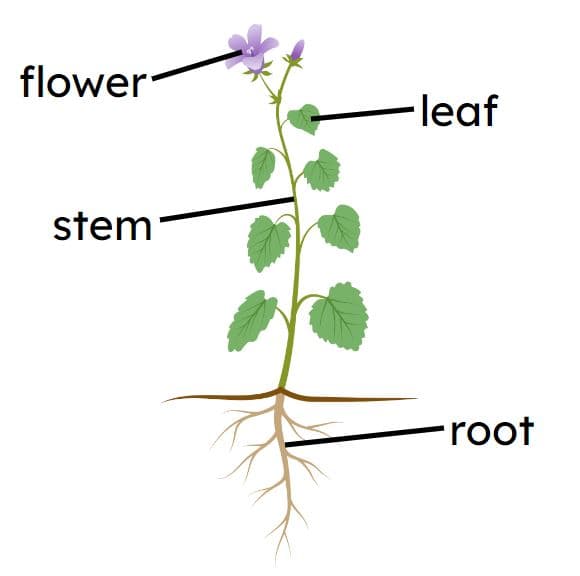Starter quiz
 Which part of the plant pictured - A, B, C or D - absorbs water for photosynthesis?
Which part of the plant pictured - A, B, C or D - absorbs water for photosynthesis?- 'D' ✓
 Which part of the plant is adapted to make a lot of glucose by photosynthesis?
Which part of the plant is adapted to make a lot of glucose by photosynthesis?- 'leaf' ✓
- Name the vessels that transport water from the roots to the leaves in plants.
- phloem
- veins
- xylem ✓
- capillaries
- arteries
-
- What may happen to a non-woody plant if the rate of uptake of water by the roots is less than the rate of transpiration?
- the plant will photosynthesise faster
- the plant will grow faster
- the plant will stop photosynthesising
- the plant will wilt ✓
-
- When it is dark at night, plants close their stomata. How will this affect life processes in the plant?
- It will increase the rate of cellular respiration.
- It will decrease the rate of photosynthesis.
- It will increase the rate of transpiration.
- It will decrease the rate of transpiration. ✓
-
- Which statement explains why the majority of stomata are on the underside of leaves?
- water is lost through stomata
- the top surface of a leaf is warmer than the lower ✓
- the waxy cuticle is on the lower surface
- there are more air spaces on the upper surface
-
Exit quiz
- Some of the __________ produced by photosynthesis is used in cellular respiration to transfer energy for life processes.
- glucose ✓
- carbon dioxide
- water
- light
- chlorophyll
-
- Which of these statements is correct?
- All plant cells can photosynthesise.
- All root cells can photosynthesise.
- All cells can photosynthesise.
- All cells with chloroplasts can photosynthesise. ✓
-
- Match each keyword to the correct meaning.
- transpiration⇔the loss of water from a plant's leaves ✓
- translocation⇔the transport of sugars and other nutrients in plants ✓
- xylem⇔specialised tissue for the transport of water and minerals ✓
- phloem⇔specialised tissue for the transport of sucrose and amino acids ✓
- Cells in plant leaves are like factories for the production of biological molecules. Match each biological molecule to the components from which it is made.
- amino acids⇔glucose and nitrate ions ✓
- starch⇔thousands of glucose molecules joined together ✓
- chlorophyll⇔glucose and magnesium ✓
 Which of these is not true of phloem tissue?
Which of these is not true of phloem tissue?- phloem tissue is alive
- phloem tissue cells have cytoplasm
- phloem cells have sieve plates between them
- phloem tissue transports only from the leaves to the roots ✓
-
- Put these stages of translocation in the correct order.
- 1⇔Active transport moves sugars from the source into the phloem.
- 2⇔This increases the concentration of sugar in the phloem.
- 3⇔Osmosis moves water into the phloem.
- 4⇔The water increases the pressure in the phloem.
- 5⇔Sugar solution moves towards the sink by translocation.
Worksheet
Loading worksheet ...
Presentation
Loading presentation ...
Video
Lesson Details
Key learning points
- Sugars, amino acids and other organic substances (nutrients) are transported in phloem.
- Translocation starts at a source, such as a leaf where sugars are made.
- Sugars are transported into phloem by active transport across the membranes of the living phloem cells.
- Water moves into the phloem cells by osmosis, which increases the pressure and pushes the sugars along the phloem tube.
- Sugars are transported out of the phloem by active transport at a sink, such as a developing root, stem or flower.
Common misconception
Students get confused between transport in the xylem (water and minerals) and the phloem (sugars).
These sections are covered in separate lessons, each with clear explanations and reinforcing tasks to support learning.
Keywords
Phloem - specialised vessels in plants that transport sugar, amino acids and other nutrients
Translocation - the process of transporting sugars and nutrients through the phloem
Source - the location that the sugars or nutrients are loaded during translocation
Sink - the location that the sugars or nutrients are unloaded during translocation
Active transport - the net movement of particles against a concentration gradient using energy
+